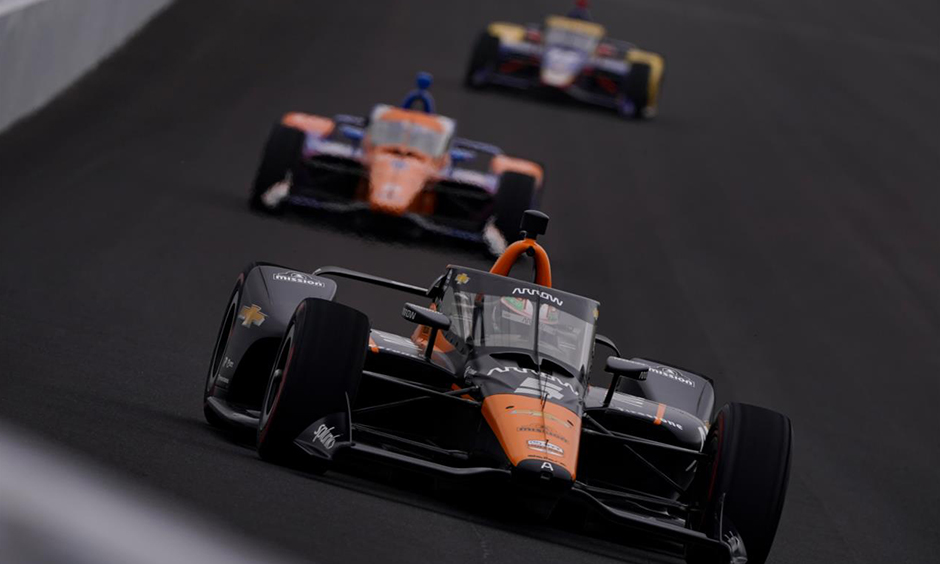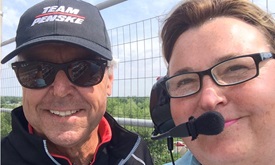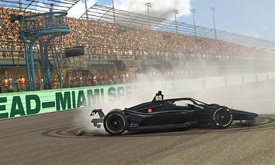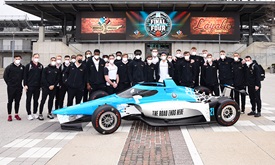Push-to-Pass Test at IMS Oval Delivers Promising Results, Feedback
MAR 26, 2021
The NTT INDYCAR SERIES continued its preparation for an engine configuration change in 2023, which includes hybrid technology, by testing a Push-to-Pass system Friday at Indianapolis Motor Speedway.
Push-to-Pass, used in INDYCAR on road courses and street circuits since 2009, gives drivers a short horsepower boost that assists with overtaking. It has never been used in an oval-track race and while it has been tested three times over the years at such venues, Friday was its first experience at the iconic 2.5-mile IMS.
Four NTT INDYCAR SERIES drivers, led by six-time and reigning season champion Scott Dixon of Chip Ganassi Racing and fellow Indianapolis 500 presented by Gainbridge winner Alexander Rossi of Andretti Autosport, participated in Friday’s session to simulate how Push-to-Pass could be used with the new 2.4-liter, twin-turbocharged V6 powerplant that will debut in 2023. Other drivers testing were two-time series champion Josef Newgarden of Team Penske and 2020 Indy 500 Rookie of the Year Pato O’Ward.
INDYCAR President Jay Frye reiterated this was one of many tests to be held before the engine configuration is used in competition.
“When we came into (this test) we thought … this would precipitate more questions than answers, and that’s probably what happened, which is fine,” Frye said. “We’re looking at how (racing) could look in 2023 with the new hybrid system coming in.”
The hybrid component features a Kinetic Energy Recovery System (KERS) that generates, stores and repurposes energy, which will be used for Push-to-Pass on road courses and street circuits – and maybe even ovals if that’s deemed the path to take.
Dixon, Rossi, Newgarden and O’Ward and their teams participated in an aerodynamic test at IMS in November, and those adjustments made then were validated in this session, Frye said.
Honda and Chevrolet each had two teams participating today.
Drivers spent more than two hours Friday afternoon running in a pack to simulate race conditions. They were given different variables for each 20-lap run, with some Push-to-Pass durations choreographed to span as little as five seconds, others more. Each duration changed the speed at which the cars reached the end of IMS’ long straightaways, with ranges from 230 mph to 236 mph, Frye said in an example.
The drivers said they could feel the difference.
“It’s interesting,” Rossi said. “You really feel (Push-to-Pass) deactivate, but you certainly feel it come in. It’s pretty cool. It’s like, ‘I’d like this power all of the time.’”
Frye said the drivers preferred the shorter durations, which was good information to learn. That’s a benefit of testing, he said.
“It’s a lot of power, and some of the durations were quite long,” Dixon said. “Ten seconds of (it is) probably 50, 60, 70 horsepower, especially on a car that’s trimmed out, and your average lap speed can jump by several miles per hour.”
NTT INDYCAR SERIES cars are in line for a horsepower increase in 2023 as the new engine can produce an estimated 100 horsepower more than the current 2.2-liter configuration. The KERS system can add another 100 horsepower, although Frye stressed all that increase might not happen at once.
“We tried to simulate how it could work,” Frye said, adding that testing on the new engines is expected in early 2022.
Previous oval Push-to-Pass tests were held at Pocono Raceway, Phoenix Raceway and World Wide Technology Raceway, but those were with a previous generation of the Push-to-Pass system.
Newgarden said this is one of the many options INDYCAR has for the future.
“The horsepower bump is (adjustable) -- you can turn the boost up or down,” he said. “So, that jump in performance off the corner can be bigger or smaller, and the length of (the Push-to-Pass) is adjustable. We ran through a couple of scenarios, a couple of configurations. It’s definitely noticeable.
“It’s just a matter of preference and what’s the right configuration to give to the field. That’s the type of info we were trying to arm INDYCAR with, and now it’s on to them to dissect that information and see what we do in the future.”
INDYCAR testing resumes this Tuesday and Wednesday at Texas Motor Speedway, in preparation for the Genesys 300 and XPEL 375 on May 1-2 on the 1.5-mile oval.
The 17-race season begins Sunday, April 18 with the Honda Indy Grand Prix of Alabama presented by AmFirst at Barber Motorsports Park in Birmingham, Alabama. The 105th Indianapolis 500 presented by Gainbridge is Sunday, May 30.




















